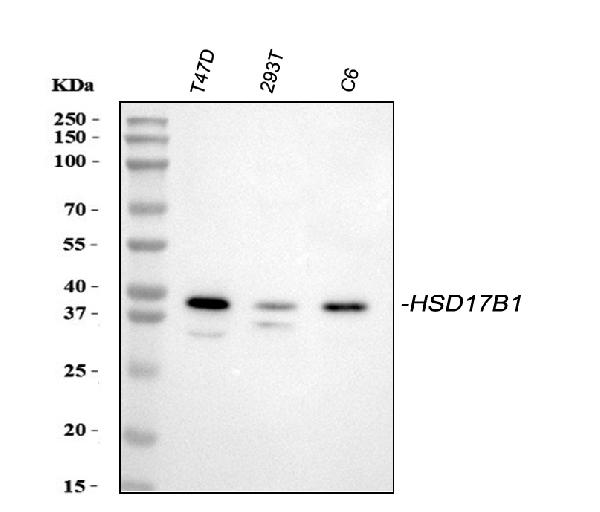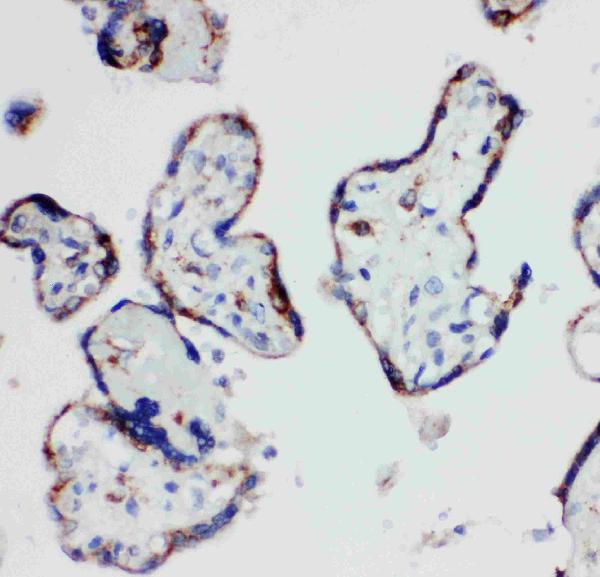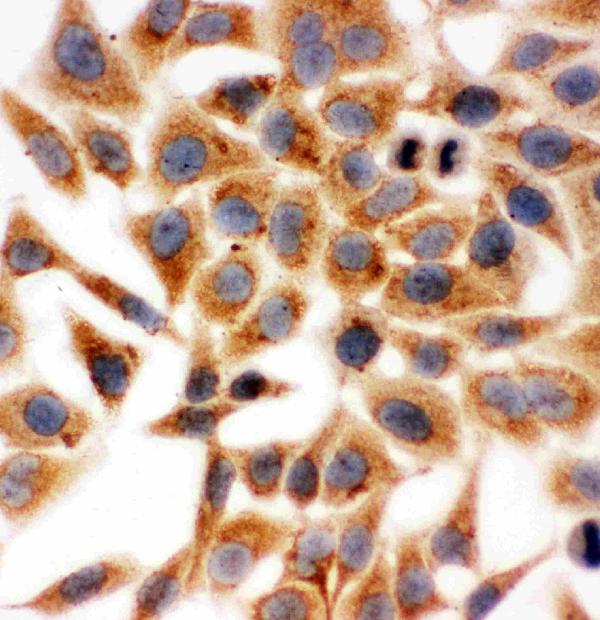Product Info Summary
| SKU: | PA1613-1 |
|---|---|
| Size: | 100 μg/vial |
| Reactive Species: | Human, Rat |
| Host: | Rabbit |
| Application: | IHC, ICC, WB |
Customers Who Bought This Also Bought
Product info
Product Name
Anti-HSD17B1 Antibody Picoband®
View all 17 beta-HSD1/HSD17B1 Antibodies
SKU/Catalog Number
PA1613-1
Size
100 μg/vial
Form
Lyophilized
Description
Boster Bio Anti-HSD17B1 Antibody catalog # PA1613-1. Tested in IHC, ICC, WB applications. This antibody reacts with Human, Rat. The brand Picoband indicates this is a premium antibody that guarantees superior quality, high affinity, and strong signals with minimal background in Western blot applications. Only our best-performing antibodies are designated as Picoband, ensuring unmatched performance.
Storage & Handling
Store at -20˚C for one year from date of receipt. After reconstitution, at 4˚C for one month. It can also be aliquotted and stored frozen at -20˚C for six months. Avoid repeated freeze-thaw cycles.
Cite This Product
Anti-HSD17B1 Antibody Picoband® (Boster Biological Technology, Pleasanton CA, USA, Catalog # PA1613-1)
Host
Rabbit
Contents
Each vial contains 5mg BSA, 0.9mg NaCl, 0.2mg Na2HPO4, 0.05mg Thimerosal, 0.05mg NaN3.
Clonality
Polyclonal
Isotype
Rabbit IgG
Immunogen
A synthetic peptide corresponding to a sequence at the N-terminus of human HSD17B1, different from the related rat and mouse sequences by one amino acid.
*Blocking peptide can be purchased. Costs vary based on immunogen length. Contact us for pricing.
Cross-reactivity
No cross-reactivity with other proteins
Reactive Species
PA1613-1 is reactive to HSD17B1 in Human, Rat
Reconstitution
Add 0.2ml of distilled water will yield a concentration of 500ug/ml.
Observed Molecular Weight
37-38 kDa
Calculated molecular weight
34950 MW
Background of 17 beta-HSD1/HSD17B1
Estradiol 17-beta-dehydrogenase 1 is an enzyme that in humans is encoded by the HSD17B1 gene. This gene encodes a member of the 17beta-hydroxysteroid dehydrogenase family of short-chain dehydrogenases/reductases. It has a dual function in estrogen activation and androgen inactivation and plays a major role in establishing the estrogen E2 concentration gradient between serum and peripheral tissues. The encoded protein catalyzes the last step in estrogen activation, using NADPH to convert estrogens E1 and E2 and androgens like 4-androstenedione, to testosterone. It has an N-terminal short-chain dehydrogenase domain with a cofactor binding site, and a narrow, hydrophobic C-terminal domain with a steroid substrate binding site. This gene is expressed primarily in the placenta and ovarian granulosa cells, and to a lesser extent, in the endometrium, adipose tissue, and prostate. Polymorphisms in this gene have been linked to breast and prostate cancer. A pseudogene of this gene has been identified. Alternative splicing results in multiple transcript variants.
Antibody Validation
Boster validates all antibodies on WB, IHC, ICC, Immunofluorescence, and ELISA with known positive control and negative samples to ensure specificity and high affinity, including thorough antibody incubations.
Application & Images
Applications
PA1613-1 is guaranteed for IHC, ICC, WB Boster Guarantee
Assay Dilutions Recommendation
The recommendations below provide a starting point for assay optimization. The actual working concentration varies and should be decided by the user.
Western blot, 0.1-0.5μg/ml, Human, Rat
Immunohistochemistry (Paraffin-embedded Section), 0.5-1μg/ml, Human, Rat, By Heat
Immunocytochemistry , 0.5-1μg/ml, Human
Positive Control
WB: human T47D whole cell, human 293T whole cell, rat C6 whole cell
IHC: Rat Liver tissue, Rat Ovary tissue, Human Placenta tissue
ICC: Hela cell
Validation Images & Assay Conditions

Click image to see more details
Figure 1. Western blot analysis of HSD17B1 using anti-HSD17B1 antibody (PA1613-1).
Electrophoresis was performed on a 5-20% SDS-PAGE gel at 70V (Stacking gel) / 90V (Resolving gel) for 2-3 hours. The sample well of each lane was loaded with 30 ug of sample under reducing conditions.
Lane 1: human T47D whole cell lysates,
Lane 2: human 293T whole cell lysates,
Lane 3: rat C6 whole cell lysates.
After electrophoresis, proteins were transferred to a nitrocellulose membrane at 150 mA for 50-90 minutes. Blocked the membrane with 5% non-fat milk/TBS for 1.5 hour at RT. The membrane was incubated with rabbit anti-HSD17B1 antigen affinity purified polyclonal antibody (Catalog # PA1613-1) at 0.5 μg/mL overnight at 4°C, then washed with TBS-0.1%Tween 3 times with 5 minutes each and probed with a goat anti-rabbit IgG-HRP secondary antibody at a dilution of 1:5000 for 1.5 hour at RT. The signal is developed using an Enhanced Chemiluminescent detection (ECL) kit (Catalog # EK1002) with Tanon 5200 system. A specific band was detected for HSD17B1 at approximately 37-38 kDa. The expected band size for HSD17B1 is at 35 kDa.

Click image to see more details
Figure 2. IHC analysis of HSD17B1 using anti-HSD17B1 antibody (PA1613-1).
HSD17B1 was detected in a paraffin-embedded section of Human Placenta tissue. Heat mediated antigen retrieval was performed in EDTA buffer (pH 8.0, epitope retrieval solution). The tissue section was blocked with 10% goat serum. The tissue section was then incubated with 1 μg/ml rabbit anti-HSD17B1 Antibody (PA1613-1) overnight at 4°C. Peroxidase Conjugated Goat Anti-rabbit IgG was used as secondary antibody and incubated for 30 minutes at 37°C. The tissue section was developed using HRP Conjugated Rabbit IgG Super Vision Assay Kit (Catalog # SV0002) with DAB as the chromogen.

Click image to see more details
Figure 3. IHC analysis of HSD17B1 using anti-HSD17B1 antibody (PA1613-1).
HSD17B1 was detected in a paraffin-embedded section of Rat Liver tissue. Heat mediated antigen retrieval was performed in EDTA buffer (pH 8.0, epitope retrieval solution). The tissue section was blocked with 10% goat serum. The tissue section was then incubated with 1 μg/ml rabbit anti-HSD17B1 Antibody (PA1613-1) overnight at 4°C. Peroxidase Conjugated Goat Anti-rabbit IgG was used as secondary antibody and incubated for 30 minutes at 37°C. The tissue section was developed using HRP Conjugated Rabbit IgG Super Vision Assay Kit (Catalog # SV0002) with DAB as the chromogen.

Click image to see more details
Figure 4. IHC analysis of HSD17B1 using anti-HSD17B1 antibody (PA1613-1).
HSD17B1 was detected in a paraffin-embedded section of Rat Ovary tissue. Heat mediated antigen retrieval was performed in EDTA buffer (pH 8.0, epitope retrieval solution). The tissue section was blocked with 10% goat serum. The tissue section was then incubated with 1 μg/ml rabbit anti-HSD17B1 Antibody (PA1613-1) overnight at 4°C. Peroxidase Conjugated Goat Anti-rabbit IgG was used as secondary antibody and incubated for 30 minutes at 37°C. The tissue section was developed using HRP Conjugated Rabbit IgG Super Vision Assay Kit (Catalog # SV0002) with DAB as the chromogen.

Click image to see more details
Figure 5. ICC analysis of HSD17B1 using anti-HSD17B1 antibody (PA1613-1).
HSD17B1 was detected in an immunocytochemical section of Hela cells. Enzyme antigen retrieval was performed using IHC enzyme antigen retrieval reagent (AR0022) for 15 mins. The cells were blocked with 10% goat serum. And then incubated with 1 μg/ml rabbit anti-HSD17B1 Antibody (PA1613-1) overnight at 4°C. Biotinylated goat anti-rabbit IgG was used as secondary antibody and incubated for 30 minutes at 37°C. The section was developed using HRP Conjugated Rabbit IgG Super Vision Assay Kit (Catalog # SV0002) with DAB as the chromogen.
Protein Target Info & Infographic
Gene/Protein Information For HSD17B1 (Source: Uniprot.org, NCBI)
Gene Name
HSD17B1
Full Name
Estradiol 17-beta-dehydrogenase 1
Weight
34950 MW
Superfamily
short-chain dehydrogenases/reductases (SDR) family
Alternative Names
Estradiol 17-beta-dehydrogenase 1;1.1.1.62;17-beta-hydroxysteroid dehydrogenase type 1;17-beta-HSD 1;20 alpha-hydroxysteroid dehydrogenase;20-alpha-HSD;E2DH;Placental 17-beta-hydroxysteroid dehydrogenase;Short chain dehydrogenase/reductase family 28C member 1;HSD17B1;E17KSR, EDH17B1, EDH17B2, EDHB17, SDR28C1; HSD17B1 17-beta-HSD, 20-alpha-HSD, E2DH, EDH17B2, EDHB17, HSD17, SDR28C1 hydroxysteroid 17-beta dehydrogenase 1 17-beta-hydroxysteroid dehydrogenase type 1|17-beta-HSD 1|20 alpha-hydroxysteroid dehydrogenase|estradiol 17-beta-dehydrogenase 1|placental 17-beta-hydroxysteroid dehydrogenase|short chain dehydrogenase/reductase family 28C member 1|short chain dehydrogenase/reductase family 28CE, member 1
*If product is indicated to react with multiple species, protein info is based on the gene entry specified above in "Species".For more info on HSD17B1, check out the HSD17B1 Infographic

We have 30,000+ of these available, one for each gene! Check them out.
In this infographic, you will see the following information for HSD17B1: database IDs, superfamily, protein function, synonyms, molecular weight, chromosomal locations, tissues of expression, subcellular locations, post-translational modifications, and related diseases, research areas & pathways. If you want to see more information included, or would like to contribute to it and be acknowledged, please contact [email protected].
Specific Publications For Anti-HSD17B1 Antibody Picoband® (PA1613-1)
Hello CJ!
PA1613-1 has been cited in 1 publications:
*The publications in this section are manually curated by our staff scientists. They may differ from Bioz's machine gathered results. Both are accurate. If you find a publication citing this product but is missing from this list, please let us know we will issue you a thank-you coupon.
Estrogen Secreted by Mesenchymal Stem Cells Necessarily Determines Their Feasibility of Therapeutical Application
Recommended Resources
Here are featured tools and databases that you might find useful.
- Boster's Pathways Library
- Protein Databases
- Bioscience Research Protocol Resources
- Data Processing & Analysis Software
- Photo Editing Software
- Scientific Literature Resources
- Research Paper Management Tools
- Molecular Biology Software
- Primer Design Tools
- Bioinformatics Tools
- Phylogenetic Tree Analysis
Customer Reviews
Have you used Anti-HSD17B1 Antibody Picoband®?
Submit a review and receive an Amazon gift card.
- $30 for a review with an image
0 Reviews For Anti-HSD17B1 Antibody Picoband®
Customer Q&As
Have a question?
Find answers in Q&As, reviews.
Can't find your answer?
Submit your question
3 Customer Q&As for Anti-HSD17B1 Antibody Picoband®
Question
We are currently using anti-HSD17B1 antibody PA1613-1 for human tissue, and we are satisfied with the IHC results. The species of reactivity given in the datasheet says human, mouse, rat. Is it likely that the antibody can work on pig tissues as well?
Verified Customer
Verified customer
Asked: 2019-08-07
Answer
The anti-HSD17B1 antibody (PA1613-1) has not been tested for cross reactivity specifically with pig tissues, though there is a good chance of cross reactivity. We have an innovator award program that if you test this antibody and show it works in pig you can get your next antibody for free. Please contact me if I can help you with anything.
Boster Scientific Support
Answered: 2019-08-07
Question
I was wanting to use your anti-HSD17B1 antibody for WB for human placenta on frozen tissues, but I want to know if it has been validated for this particular application. Has this antibody been validated and is this antibody a good choice for human placenta identification?
Verified Customer
Verified customer
Asked: 2019-07-31
Answer
As indicated on the product datasheet, PA1613-1 anti-HSD17B1 antibody has been validated for IHC, ICC, WB on human, mouse, rat tissues. We have an innovator award program that if you test this antibody and show it works in human placenta in IHC-frozen, you can get your next antibody for free.
Boster Scientific Support
Answered: 2019-07-31
Question
Would anti-HSD17B1 antibody PA1613-1 work for WB with placenta?
S. Anderson
Verified customer
Asked: 2017-12-22
Answer
According to the expression profile of placenta, HSD17B1 is highly expressed in placenta. So, it is likely that anti-HSD17B1 antibody PA1613-1 will work for WB with placenta.
Boster Scientific Support
Answered: 2017-12-22




